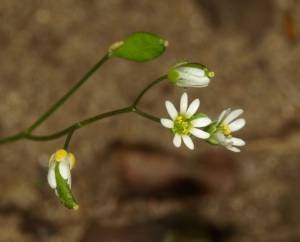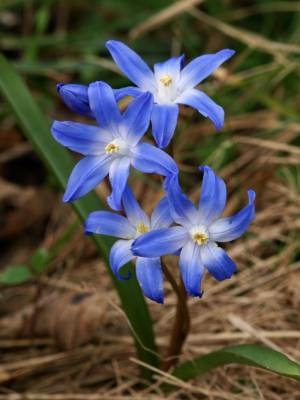Dr Phil Smith’s Wildlife Notes
Mar 2007
March and April are characterised by increasing bird song and lots of spring flowers. The older sand-dunes are sprinkled with tiny annual plants, the earliest being Spring Whitlowgrass (Erophila verna), a member of the cabbage family with four white, notched petals and a small rosette of hairy leaves. Also, look out for the Early Forget–me-not (Myosotis ramosissima) which has minute sky-blue flowers. These are common species but I was delighted recently when Mike Wilcox showed me the much scarcer Glabrous Whitlowgrass (Erophila glabrescens) in the carpark outside my flat. A new tick for me! All these annuals die off in late spring and survive the summer as drought-resistant seeds.

Another feature of the duneland is spring bulbs, most of which are escapes from gardens but which do very well in the well-drained sandy soil. In February there were some fine displays of Snowdrops (Galanthus nivalis). These were followed by two species of Glory-of-the-snow (Chionodoxa), Siberian Squill (Scilla siberica) and Garden Grape-hyacinth (Muscari armeniacum). Look for their blue flowers near to housing in areas such as Kenilworth Road and Falklands Way dunes in Ainsdale, Hesketh Road, Marshside and Range Lane, Formby. Also strikingly blue is the miniature Iris (Iris reticulata) which Maria Knowles and others found, perhaps deliberately planted, near Blundell Avenue, Formby.

You can hardly miss the spectacular numbers of Daffodils (Narcissus) at this time of year. They are nearly all garden varieties, although I have found a colony of the native species Narcissus pseudonarcissus on Ainsdale National Nature Reserve. I like Daffodils, being intrigued by the many different kinds that can be found on the dunes, often with vibrant colours (other than yellow) and exotic shapes. There are about 4000 known varieties, so identification is a real problem. Last year, I sent a selection to Professor Crawley at Imperial College, London. He is an expert in this group and named 24 cultivars from the Sefton Coast, though there are certainly more than that.
The mild weather led to Common Toads spawning as early as 23rd February; soon we can expect our local speciality the Natterjack Toad to come out of hibernation. The males assemble at night from mid-April at duneland pools and attract the females with a rattling croak that can be heard up to a mile away. They used to be known as the “Southport Nightingales” and “Bootle Organs”. We have about 40% of all the British Natterjacks and a lot of effort goes into conserving them and monitoring their populations. Each spring, guided walks are organised for the public to see the toads.
Of late, Marshside has been the place to see interesting birds, with American Green-winged Teal, up to 46 Avocets and a spectacular flock of around 3000 Black-tailed Godwits. Regular visitors to the RSPB reserve also include Peregrine and Merlin, while there are usually a few Little Egrets about. The latter is a recent colonist from continental Europe, whose increasing presence in England is probably linked to global warming.
Another group responding spectacularly to climate change is the dragonflies. Thirty years ago we had only 12 species; now there are 23 with more being discovered almost every year. They are now the subject of an Atlas Project to map their distribution in north Merseyside, Lancashire and Greater Manchester. The survey will run until 2009 and readers interested in taking part are invited to contact me for further details.
